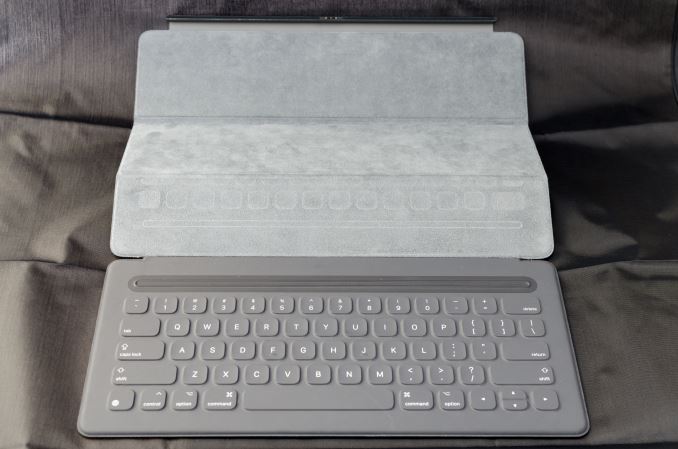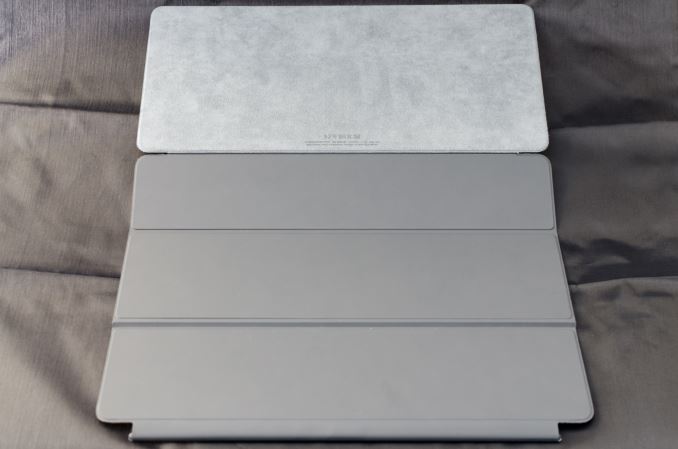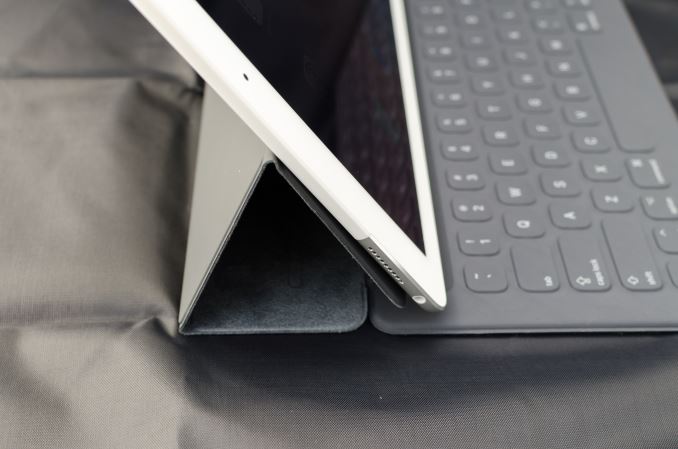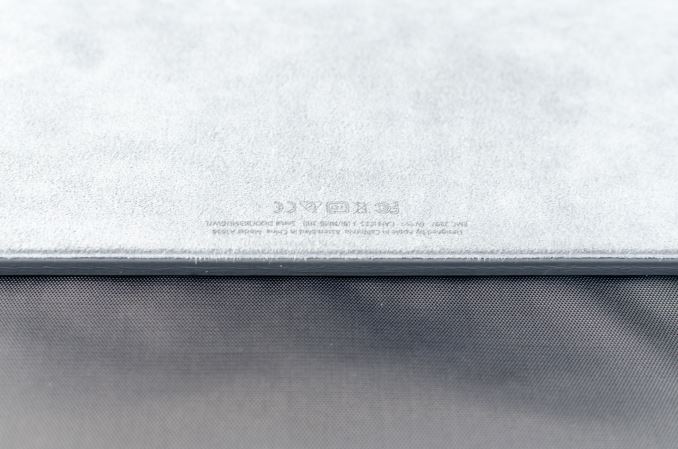The Apple iPad Pro Review
by Ryan Smith, Joshua Ho & Brandon Chester on January 22, 2016 8:10 AM ESTSmart Keyboard
The other half of what makes the iPad Pro worth talking about is the Smart Keyboard. For those that are unfamiliar with how this keyboard works, in essence it’s really a flip cover that happens to hide a keyboard inside of it. This is yet another thing I mentioned that the iPad really needed to improve its potential as a productivity tool.
I’m going to go ahead and spoil this section by saying that while the Smart Keyboard is worthwhile if you’re typing out more than a paragraph, this feels like one of the clunkier aspects of the iPad Pro.
However, the important question is how I got to that conclusion. Going over the user experience of the keyboard is a pretty simple matter. Attaching the cover to the tablet works the same way it always does, which is accomplished by placing the edge of the cover onto the edge of the tablet which also contains the Smart Connector. There are some strong magnets that help with alignment here, and provide the positive pressure needed to ensure that the data and power pins of the Smart Connector are firmly connected to the keyboard.
Once the cover is connected, setting up the keyboard is done by folding it out and doing some origami until the tablet is docked into the right place on the keyboard, which has a noticeable notch to it. Aligning this despite the strong magnets does take some work, as it seems that unless the cover is setup correctly the keyboard isn’t enabled at all.
If you’re trying for precision, I would say that there’s roughly a 4-5 second time delay from the moment that you decide that you need to use the keyboard to actually using it. In addition to this time delay, the keyboard is rather precarious and is basically only stable when you’re using it on a table. While gravity can keep the whole setup somewhat stable on your lap when the display is leaning backwards, if the display starts leaning forwards there’s really nothing stopping it from collapsing and detaching from the cover, as while the magnets are strong enough to hold the tablet in a static state, they aren’t strong enough to hold the tablet if there’s the additional force of decelerating the tablet as it falls. As a result, the angles that the keyboard and tablet can hold relative to each other is fixed.
To be fair, once the keyboard is set up and it’s in a stable position, typing on the tablet is a great experience. The Surface Pro 3 was decent in my experience, but the touchpad with its lack of strong palm rejection made for some frustrating experiences. In this respect, the iPad Pro does a lot better, to the extent that I didn’t have any trouble doing things like typing up long forum posts or various sections of this review. Key travel is short, but there’s good haptic feedback and the layout of the keyboard doesn’t have any strange issues that seem to happen so often to so many tablet keyboards. Something like the Pixel C just doesn’t even compare here, especially because due to the use of Bluetooth it’s absolutely useless in an apartment or any remotely dense environment where the 2.4 GHz spectrum is crowded to the point that it approaches being unusable.
However, despite this significant setup time for the keyboard cover, pretty much the only value for the keyboard cover is text input. Due to the ergonomics of a near-vertical touch screen it’s really not something that can be used for extended periods of time as once you’re done with text input to comfortably use the touch screen you really need to break down the keyboard and revert it back to a simple tablet.
I’ve spent a lot of time thinking about the conundrum of the keyboard when it comes to these tablets, and honestly I don’t think anyone has figured out the right way of doing things yet. I think the Pixel C in form is a step in the right direction, but the execution is unfortunate to say the least. The iPad Pro touchscreen keyboard has the size to allow for touch typing, but the utter lack of position feedback makes it difficult to know where to keep your hands and because touching the display means inputting a character it’s necessary to awkwardly keep your hands right above the glass of the display. The heart of the issue here is that it’s necessary to have an input method where it’s easy to keep your fingers resting on the home row of the keyboard, with clear haptic feedback for input and some indication of where the keys are. It’s also necessary to make sure that this keyboard is easily accessible when it’s needed but quickly stowed away when it isn’t.
I can’t help but wonder whether the better solution here would be something like Lenovo’s Yoga Pro design, but with a different method of execution. Instead of making the two halves a single unit, the keyboard portion should be easily and quickly detached with the smart connector held within the hinge. Rather than a traditional laptop keyboard, something more like the current Smart Keyboard would make a lot of sense. However, I suspect that in doing this a traditional flip cover would no longer make sense as the keyboard would really become an integral part of the user experience once properly integrated. We can talk about how touch-only is a faster and more convenient experience, but this really only applies to navigation as while I can type at about 40 words per minute without issue on a phone or tablet trying to reach 100 words per minute is hard to say the least.
Overall, I should make it clear that the iPad Pro’s Smart Keyboard is not a bad keyboard by any means. When I’m able to just focus on typing, the user experience far exceeds pretty much anything else I’ve tried in the industry. The problem is that as the Smart Keyboard starts to approach the point where I can actually use it, I start to really notice all of the flaws that the implementation has. In this case, the two major issues that really need to be solved here are speed to deploy/stow and lap stability. While a lot has been made of the iPad Pro’s inability to have adjustable viewing angles realistically it only needs two viewing angles, similar to how the Smart Cover only has two viewing angles. If the Smart Keyboard can feel like it appears and disappears almost instantly and can be used without a table effectively, it would probably be the ideal solution to the keyboard problem that tablets face.















408 Comments
View All Comments
xerandin - Saturday, January 23, 2016 - link
In what way did Microsoft saw Surface Pro parts off of other products? You know what's better than that "most stable, secure, and highest quality mobile OS?" For most people, that would be Microsoft Windows--even if they love to complain about it, you can't deny Microsoft's ubiquity in the Professional space (and home userspace, too, but we're trying to keep this in the professional sector, right?)I've heard a few people at work say that the sysadmins love Macs (it was a Director obsessed with his Macbook telling me this), but I can't seem to find any of these supposed Mac-lovers. It could have something to do that they're a nightmare to administer for most sysadmins running a domain (which covers the vast majority of sysadmins), or the fact that Mac users tend to be just as inept and incapable as Windows users, so you get to have another pain-in-the-ass group of users to deal with on a system that just isn't very nice to administer.
If you take off your hipster glasses for a moment and actually use computers in the world we live in, there's no way around the reality that Microsoft wins in the Professional space--including their beautifully made, super-powerful Surface Pro.
And no, I'm not a Microsoft shill, I just can't stand Apple fanboys with more money than sense.
gistya - Sunday, January 24, 2016 - link
Xerandin, you have no idea what you are talking about. 90% of the professional software development studios I work with are almost solely Mac based, for the simple reason that they barely need an IT department at all, in that case.Windows is technical debt, plain and simple. It's legacy cruft stuck to the face of the world. The only IT guys that hate Macs are the idiot ones who don't know bash from tsch and couldn't sudo themselves out of a wet paper box. Then there are the smart ones who know that a shift to such a low maintenance platform would mean their department would get downsized.
But so many companies are stuck on crap like SAP, NovellNetware, etc., that Microsoft could literally do nothing right for 10 years and still be a powerhouse. Oh wait.
Apple hardware is worth every extra cent it costs, and then some; if you make such little money that $500 more on a tool that you'll professionally use 8-12 hours a day for three years is a deal-breaker, then I feel very sorry for you.
But personally I think it's more than worth it to have the (by far) best screen, trackpad, keyboard, case, input drivers, and selection of operating systems. I have five different OS's installed right now including three different versions of windows (the good one, and then the most recent one, and the one that my last job still uses, which does not receive security patches and gets infected with viruses after being on a website for 10 seconds).
As for the iPad Pro, all of you fools just don't understand what it is, or why the pencil is always sold out everywhere, or what the difference is. As a software developer I can tell you that there is the most extreme difference; and that more development for iOS is being done now than ever before, and is being done at an accelerating pace. This is just version 1.0 of the large-size, pro type model for Apple, and those of us who did not buy it yet and who are still waiting for that killer app, are basically saying that well, once that app comes out, then heck yes we'll buy it. Do you seriously believe that no company will rise up to capitalize on that obviously large market? Someone will, and frankly lets hope it's not Adobe.
I regularly see iPad pros now in the hands of the professional musicians and producers I work with, and they are most certainly using them for professional applications. That's a niche to be sure, but everyone who thinks that the surface pro 4 (a mildly crappy laptop with a touchscreen that makes a bad, thick tablet and an underpowered, overheated laptop) is even remotely in the same category of device, is utterly smoking crack.
doggface - Sunday, January 24, 2016 - link
I think it might be you smoking the crack there mate. Cor, what a rant. Microsoft are pretty safe in enterprise and it has everything to do with managing large networks(1000s not 10s of computers.. Please, direct me to Apple's answer to sccm, please show me Apple's answer to exchange. Please show me an Apple only environment running 1000 different apps outside ofGoogle and Apple HQ. Just aint haopening.Constructor - Sunday, January 24, 2016 - link
IBM (yes, the IBM!) has just announced that they will switch over to Macs a while ago. And they're neither the first nor the last. Springer (a major german media company) had done that a while ago already for similar reasons (removing unproductive friction and cutting the actual cost of ownership due to less needed user support).I know that many people had imagined that Windows would be the only platform anyone would ever need to know, but that has always just been an illusion.
damianrobertjones - Monday, January 25, 2016 - link
Link to the article please! They're THINKING of using Apple for mobile use... .Constructor - Monday, January 25, 2016 - link
Nope. They're massively ramping up Mac purchases as well, with a target of 50-75% Macs at IBM. They are already full steam ahead with it:http://www.i4u.com/2015/08/93776/ibm-purchase-2000...
(Okay: The official announcements don't have that aspect, but an internal video interview with IBM's CIO leaked to YouTube makes it rather explicit even so.)
One of the motivators is apparently that despite higher sticker prices the total cost of ownership is lower for Macs (which is not news any more, but having IBM arriving at that conclusion still says something).
Oxford Guy - Wednesday, January 27, 2016 - link
Gartner said in 1999 that Macs were substantially cheaper in TCO.mcrispin - Tuesday, January 26, 2016 - link
doggface, you speak with confidence where that confidence isn't deserved. I've managed deployments of OS X way over 10k, there are plenty of places with deployments this high. JAMF Casper Suite is the "SCCM of Apple", I don't need an "Apple" replacement for Exchange, 0365 and Google are just fine for email. There are plenty of non-Apple/Google Apps for OS X and iOS. You are seriously misinformed about the reality of the OS X marketplace. Shame that.Ratman6161 - Wednesday, January 27, 2016 - link
mcrispin...sure you can find individual shops that have done big MAC deployments. but its anecdotal evidence. Its like looking at one neigborhood in my city and from that conclude that trailer parks are the norm in my city of 15,000.Take a look at this Oct 2015 article on Mac market share (I'm assuming you dont consider Apple Insider to be a bunch of Microsoft shills?) http://appleinsider.com/articles/15/10/08/mac-gain...
While touting how Mac is gaining market share they show a chart where in Q32015 they were at 7.6%. The chart is by company and even smaller Windows PC vendors Asus and Acer are at 7.1 and 7.4 respectively. Throw in Lenovo, HP and Dell at 20.3%, 18.5%, 13.8% and the 25.3% "others" (and others are not MAC's because Apple is the only company with those).
So IBM is doing 50 - 75% Mac's? OK Ill take your word for that but so what? In the larger scheme of things Apple still has only 7.6% and selling some computers to IBM isn't going to siginificantly change that number. Also, don't forgot that some companies (that compete with Microsoft in various areas) will not use a Microsoft product no mater how good it was.
No matter how you look at it, Windows is the main stream OS for busineses world wide. Touting the exceptions to that doesn't cange the truth of it.
Constructor - Wednesday, January 27, 2016 - link
Of course most workplace computers now are PCs. The thing is just that Macs are making major inroads there as well.$25 billion in Apple's corporate sales are already very far removed from your theory (and that's even without all the smaller shops who are buing retail!).